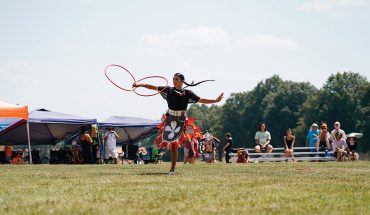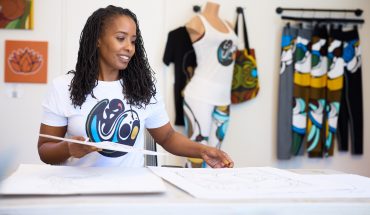Sense of Place
Tactile’s hands-on design approach
by Jessie Ammons
photographs by Geoff Wood
“There’s nothing sitting in here that’s finished,” says Courtney Evans, co-founder and director of design at Tactile Workshop, a design and fabrication shop in Raleigh. That’s because there’s no room for anything complete in this crowded but tidy space – finished projects are immediately installed in their intended homes. On a recent busy Wednesday, Evans is at her desk in a makeshift office area tucked into this workshop full of metal, wooden beams, and blueprints. Dozens of architectural projects are underway.
Among Tactile’s completed projects are a larger-than-life loom at the N.C. Museum of Art’s new African art gallery; the steel exterior of chef Scott Crawford’s Crawford & Son restaurant; The Assembly’s sleek downtown coworking space. “We operate from the ideology that architecture can be better than it is,” Evans says. Tactile Workshop makes it “better” with a combination of art and know-how. The studio itself is example A: “Art, design, and fabrication all intermingle in everything we do.”
Tactile began four years ago, when Evans and co-founder Lauren Pegram sought to “build the things that we had been designing for so long, that had never been built the way we wanted them to be.” With a bachelor’s degree in industrial and systems engineering and a master’s in architecture, both from N.C. State – plus time spent working with Raleigh visionaries including industrial artist Matt McConnell and architect Frank Harmon – Evans put it all together. Literally. “There’s the mission of wanting to make the whole built environment here (in Raleigh) better.”
Tactile began by building custom elements of others’ designs and quickly became a go-to for many of the city’s architecture firms: bookshelf walls, bar details, modern furniture. The duo earned the nickname “the welder girls.”
This year, they’ve expanded Tactile’s vision to embrace the art-centric mindset that Evans says is at the core of their love of design. The team is bigger, and projects include interior design alongside fabrication. Pegram has taken a leave of absence to earn an MFA in sculpture at the Rhode Island School of Design, and Evans has brought on three new colleagues to keep the momentum going.
Chief among them is Sam Adams, an architect with a bent for interior design. Adams is a former capital projects manager at NCMA, a role that led him to hire Tactile for the museum’s iron entryway banner system in 2016. He was impressed with Evans’ gumption; she was eager for fresh collaborators. The two hit it off, and ultimately Adams joined Tactile full-time.
There’s also architect Lauren Diaz, a skilled shop-drawer, and blacksmith Scott Mundorf, a shrewd factotum; together, the team is well-equipped to make many visions a reality. “Our whole model is one of collaboration,” Evans says, which applies to their clients, too. “Nobody hires us to do whatever we want. We activate and engage with our clients.”
Increasingly, clients seek out Tactile less for a single custom element and more for comprehensive design, from architectural renderings to interior decor suggestions. And while the firm is building up its interior design portfolio, Evans’ passion remains focused on public installations in restaurants, bars, museums, and other places “that see more activity” to achieve the biggest impact. Impact comes from physical presence, Evans says, which is why she named the firm Tactile: “We see projects through to the end. Touching is the final-level detail of what we’re trying to achieve. The final test is by touch. And, more broadly, it’s all about an interaction, which often begins with touch. … I think we should all be more engaged with our built world, in some way.”









